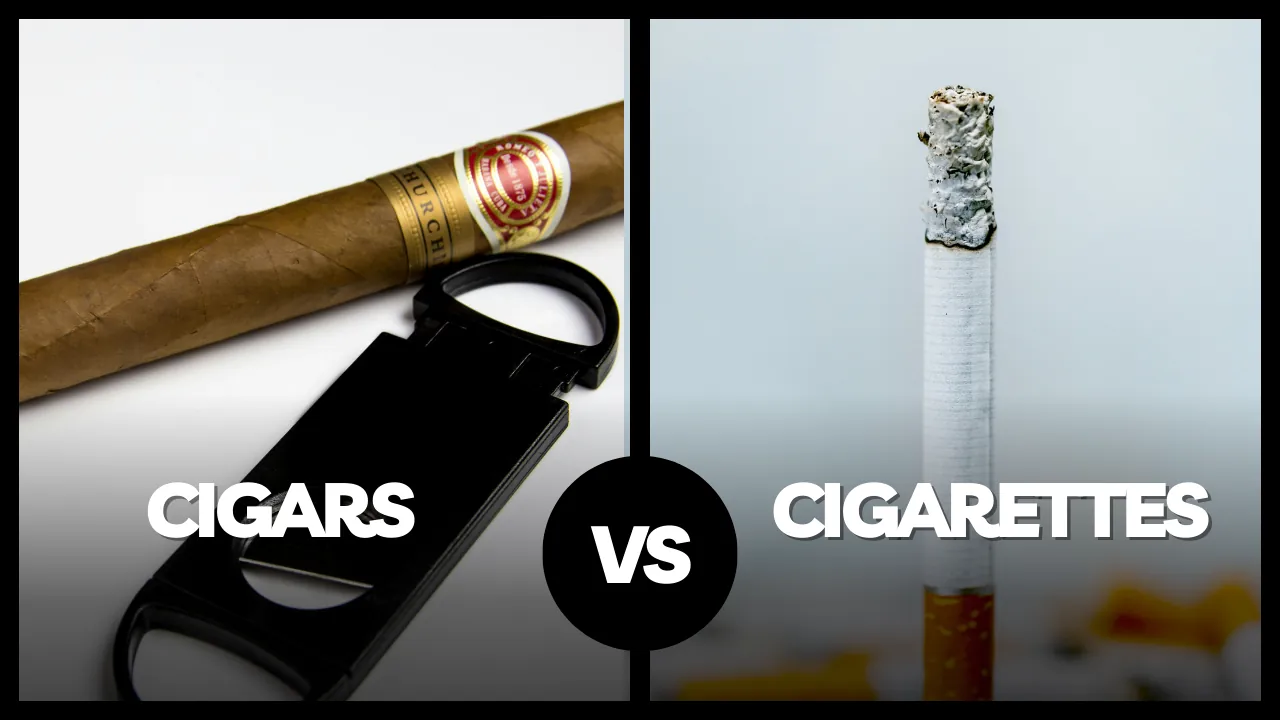Tobacco has shaped cultures and histories, with cigars and cigarettes each leaving their distinct marks. While both derive from tobacco, their composition, size, usage, and social significance create entirely different smoking experiences. This guide dives into the contrasts between cigars and cigarettes, highlighting what sets them apart.
Cigars vs Cigarettes: Composition
The composition of cigars and cigarettes is the foundation of their differences. While both use tobacco, their preparation, and additional ingredients create distinct smoking experiences.
Cigarettes
Cigarettes are made from finely cut tobacco leaves wrapped in thin paper. Manufacturers often add chemicals to influence flavor, aroma, and burning consistency. Common additives include:
- Menthol: Creates a cooling sensation.
- Flavorings: Enhance taste.
- Paper Chemicals: Control burn rate.
These additions make cigarettes convenient and uniform, catering to quick nicotine satisfaction.
Cigars
Cigars are crafted from whole tobacco leaves, meticulously fermented and aged to develop flavor and aroma. Unlike cigarettes, cigars usually lack added chemicals, offering a purer tobacco taste. With no filters, cigars deliver a fuller, more robust experience that prioritizes flavor over convenience.
Cigars vs Cigarettes: Size and Shape

Cigars and cigarettes differ greatly in size and shape, influencing how they are smoked and the duration of the experience. These physical differences reflect their respective roles in smoking culture.
Cigars
Cigars vary significantly in size and shape, with options like:
- Parejo: Straight-sided.
- Figurado: Unconventional shapes.
- Presidente: Extra-long and thick.
These variations influence smoking duration and style, often creating a leisurely experience lasting up to several hours.
Cigarettes
Cigarettes are smaller and uniformly sized, typically about 85mm long. Their compact form suits quick consumption, aligning with the fast-paced demands of modern life.
Cigars vs Cigarettes: Smoking Experience & Duration
The smoking experience varies dramatically between cigars and cigarettes. While one focuses on speed and efficiency, the other is about leisure and savoring.
Cigarettes
Cigarettes offer a quick smoking experience, typically lasting a few minutes. Smokers inhale the smoke deeply into their lungs, enabling rapid nicotine absorption. This makes cigarettes more about satisfying cravings than savoring the act of smoking.
Cigars
Cigars provide a longer experience, ranging from 30 minutes to several hours. Smokers savor the smoke in their mouths without inhaling it deeply. The focus is on flavor and aroma, making the experience more ritualistic and indulgent.
Cigars vs Cigarettes: Nicotine Content
Nicotine levels differ between cigars and cigarettes, affecting how smokers consume and absorb it. Understanding these differences sheds light on their varying impacts.
Cigars
Cigars contain more nicotine due to their size and use of whole-leaf tobacco. A single cigar can deliver as much nicotine as several cigarettes. However, because cigar smoke is not usually inhaled, nicotine absorption occurs more slowly.
Cigarettes
Cigarette nicotine is inhaled directly into the lungs, leading to faster absorption and a stronger immediate effect. Nicotine levels vary by brand, but cigarettes typically deliver smaller amounts per session compared to cigars.
Cigars vs Cigarettes: Packaging

Packaging serves as a visual representation of how cigars and cigarettes are marketed and consumed. While cigarettes focus on convenience, cigars emphasize luxury.
Cigarettes
Cigarettes are sold in packs of 20 or more, designed for portability and convenience. Their packaging reflects their role as a daily habit rather than a luxury item.
Cigars
Cigars are often sold individually or in small packs of 1-5. Their packaging exudes sophistication, catering to a slower, more deliberate consumption style.
Cigars vs Cigarettes: Social Context
The social context of smoking varies significantly between cigars and cigarettes. Cigars are often tied to celebrations and luxury, while cigarettes cater to individual habits and routine use.
Cigars
Cigars are associated with luxury, celebration, and refinement. They are often smoked during significant events, like weddings or business milestones, and are enjoyed in social settings like cigar lounges or clubs.
Cigarettes
Cigarettes are seen as an everyday habit, primarily consumed to satisfy nicotine cravings. They are associated more with individual use than with communal or celebratory contexts.
Cigars vs Cigarettes: Health Risks
Both cigars and cigarettes carry significant health risks, although the ways they affect the body differ. Understanding these risks is crucial for making informed choices about tobacco use.
Cigarettes
Cigarettes are strongly linked to lung cancer, heart disease, and respiratory illnesses due to deep inhalation and the presence of additives.
Cigars
Cigars also carry risks, including oral, throat, and lung cancers. While less frequent inhalation might reduce lung damage, the overall health risks remain severe.
How Many Cigarettes Equal a Cigar?

Comparing cigars to cigarettes in terms of nicotine content reveals their significant differences. A single cigar can often match or exceed the nicotine in multiple cigarettes.
The nicotine content of a single cigar can equal that of 5-10 cigarettes, depending on its size and smoking method. Factors such as puff frequency, smoke inhalation, and the duration of the session affect nicotine absorption.
For context:
- A small cigar might contain nicotine comparable to 1-2 cigarettes.
- A large cigar can rival or exceed the nicotine of a full pack of cigarettes.
Final Thoughts
Cigars and cigarettes differ in composition, size, smoking style, and social context. Cigars are about savoring an experience, while cigarettes cater to convenience and addiction.
Despite these differences, both share significant health risks. Smoking, whether cigars or cigarettes, demands informed decisions and a clear understanding of its effects. Ultimately, mindful consumption is key to navigating the fine line between enjoyment and harm.

Leave a Reply